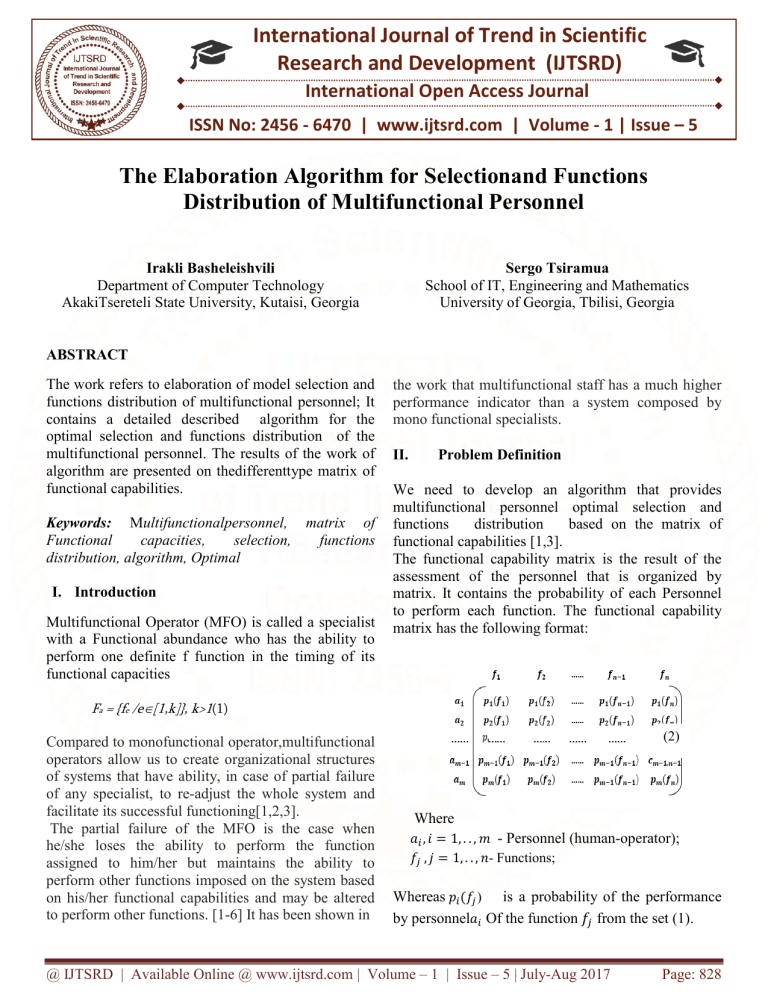
International Journal of Trend in Scientific
Research and Development (IJTSRD)
International Open Access Journal
ISSN No: 2456 - 6470 | www.ijtsrd.com | Volume - 1 | Issue – 5
The Elaboration Algorithm for Selectionand Functions
Distribution of Multifunctional Personnel
Irakli Basheleishvili
Department of Computer Technology
AkakiTsereteli State University, Kutaisi, Georgia
Sergo Tsiramua
School of IT, Engineering and Mathematics
University of Georgia, Tbilisi, Georgia
ABSTRACT
The work refers to elaboration of model selection and
functions distribution of multifunctional personnel; It
contains a detailed described algorithm for the
optimal selection and functions distribution of the
multifunctional personnel. The results of the work of
algorithm are presented on thedifferenttype matrix of
functional capabilities.
Keywords: Multifunctionalpersonnel, matrix of
Functional
capacities,
selection,
functions
distribution, algorithm, Optimal
I. Introduction
Multifunctional Operator (MFO) is called a specialist
with a Functional abundance who has the ability to
perform one definite f function in the timing of its
functional capacities
the work that multifunctional staff has a much higher
performance indicator than a system composed by
mono functional specialists.
II.
Problem Definition
We need to develop an algorithm that provides
multifunctional personnel optimal selection and
functions
distribution
based on the matrix of
functional capabilities [1,3].
The functional capability matrix is the result of the
assessment of the personnel that is organized by
matrix. It contains the probability of each Personnel
to perform each function. The functional capability
matrix has the following format:
Fa = {fe /e[1,k]}, k>1(1)
Compared to monofunctional operator,multifunctional
operators allow us to create organizational structures
of systems that have ability, in case of partial failure
of any specialist, to re-adjust the whole system and
facilitate its successful functioning[1,2,3].
The partial failure of the MFO is the case when
he/she loses the ability to perform the function
assigned to him/her but maintains the ability to
perform other functions imposed on the system based
on his/her functional capabilities and may be altered
to perform other functions. [1-6] It has been shown in
(2)
Where
𝑎𝑖 , 𝑖 = 1, . . , 𝑚 - Personnel (human-operator);
𝑓𝑗 , 𝑗 = 1, . . , 𝑛- Functions;
Whereas 𝑝𝑖 (𝑓𝑗 ) is a probability of the performance
by personnel𝑎𝑖 Of the function 𝑓𝑗 from the set (1).
@ IJTSRD | Available Online @ www.ijtsrd.com | Volume – 1 | Issue – 5 | July-Aug 2017
Page: 828
International Journal of Trend in Scientific Research and Development (IJTSRD) ISSN: 2456-6470
The matrix of the functional capability is mxn size,
which should satisfy the following condition n <= m,
because selection and function distribution are
required to perform the number of personnel more or
equal to the number of functions.
III.
Matematical model of selection and
functions distribution
largely based on the earlier works of two Hungarian
mathematicians: DénesKőnig and JenőEgerváry.[6-8]
James Munkres reviewed the algorithm in 1957 and
observed that it is (strongly) polynomial.[6-8] Since
then the algorithm has been known also as the Kuhn–
Munkres algorithm or Munkres assignment algorithm.
IV.
Structure of selection and functions distribution
problem is similar to the structure of the assignment
problem.
The assignment problem is one of the fundamental
combinatorial optimization problems in the branch of
optimization or operations research in mathematics.
Selection and functions distribution problem:
𝑚
𝑛
∏ ∏ pi ( f j ) xij → Max (3)
𝑖=1 𝑗=1
Where
𝑛
∑ 𝑥𝑖𝑗 = 1, 𝑖 = 1, … , 𝑚
𝑗=1
𝑚
∑ 𝑥𝑖𝑗 = 1, 𝑗 = 1, … , 𝑛
𝑖=1
1 , 𝑖𝑓 𝑖 𝑜𝑝𝑒𝑟𝑎𝑡𝑜𝑟 𝑎𝑠𝑠𝑖𝑔𝑛𝑒𝑑 𝑗 𝑓𝑢𝑛𝑐𝑡𝑖𝑜𝑛
𝑥𝑖𝑗 = {
0, 𝑖𝑓 𝑖 𝑜𝑝𝑒𝑟𝑎𝑡𝑜𝑟 𝑛𝑜𝑡 𝑎𝑠𝑠𝑖𝑔𝑛𝑒𝑑 𝑗 𝑓𝑢𝑛𝑐𝑡𝑖𝑜𝑛
We use the Hungarian algorithm for the personnel
selection and functions distribution.
The Hungarian method is a combinatorial
optimization algorithm that solves the assignment
problem in polynomial time and which anticipated
later primal-dual methods. It was developed and
published in 1955 by Harold Kuhn, who gave the
name "Hungarian method" because the algorithm was
Algorithm for Selection and Functions
Distribution of Multifunctional Personnel
Steps of the algorithm for the selection and functions
distribution of multifunctional personnel:
Step 1: In matrix of functional capabilities each
element multiplicationon (-1). Go to Step 2;
Step2: Find the element whose absolute (abs) value is
the most max and add the found value to every
element in the matrix. Go to Step 3;
Step 3: Make the matrix a square matrix, to fill it with
the column of zero elements. Go to Step 4;
Step 4: For each row, find the lowest element and
subtract it from each element in that row. Go to Step
5;
Step5: For each column, find the lowest element and
subtract it from each element in that column.Go to
Step 6;
Step6: Cover all zeros in the resulting matrix using a
minimum number of horizontal and vertical lines. If
m lines are required, an optimal assignment exists
among the zeros. The algorithm stops. If less than m
lines are required, continue with Step 7.
Step 7: In the resulting matrixfind the smallest
element that is not covered by a line in Step 6.
Subtract found element from all uncovered elements,
and add to all elements that are covered twice.Go to
Step 6;
The algorithm presented in the work is implanted in
the programming language c #.
@ IJTSRD | Available Online @ www.ijtsrd.com | Volume – 1 | Issue – 5 | July-Aug 2017
Page: 829
International Journal of Trend in Scientific Research and Development (IJTSRD) ISSN: 2456-6470
Start
P [ n , m]
For element eP[n, m]
e=e*(-1)
g= Max(abs((P[n,m]))
For element eP[n, m]
e=e+g
n=m
No
Make the matrix a square
matrix, to fill it with the
column of zero elements
Yes
For row Rin P
for element e in R
e=e-min(R)
For column C in P
for element e in C
e=e-min(C)
Cover all zeros in the
resulting matrix using a
minimum
number
of
horizontal and vertical
lines.
Lines number<m
Yes
In the resulting matrixfind the
smallest element that is not covered
rows and columns. Subtract found
element
from
all
uncovered
elements, and add to all elements
that are covered twice.
No
Optimal solution
End
Fig 1: Algorithm block flow diagram
@ IJTSRD | Available Online @ www.ijtsrd.com | Volume – 1 | Issue – 5 | July-Aug 2017
Page: 830
International Journal of Trend in Scientific Research and Development (IJTSRD) ISSN: 2456-6470
Consider the performance of the algorithm on a
variety of functional capacities matrix:
a) Table 1. matrix of functional capacities 6x6
𝒂𝟏
𝒂𝟐
𝒂𝟑
𝒂𝟒
𝒇𝟏
0.8
0.7
0.84
0.84
𝒇𝟐
0.7
0.58
0.95
0.41
𝒇𝟑
0.74
0.71
0.75
0.89
𝒇𝟒
0.6
0.87
0.85
0.7
𝒇𝟓
0.7
0.95
0.9
1
𝒇𝟔
0.9
0.6
0.74
0.6
𝒂𝟓
0.69 0.86 0.47 0.96 0.74 0.5
𝒂𝟔
0.6
Fig.3 Program execution result
The selection and the functions distribution have the
following look:
𝒂𝟏 → 𝒇𝟏 ;
𝒂𝟑 → 𝒇𝟐 ;
0.58 0.75 0.69 0.85 0.47
𝒂𝟒 → 𝒇𝟑 ;
c)
Table 3: matrix of functional capacities 6x4
Fig 2: Program execution result
The selection and the functions distribution have the
following look:
𝒂𝟏
𝒂𝟐
𝒂𝟑
𝒂𝟒
𝒇𝟏
0.8
0.7
0.84
0.84
𝒇𝟐
0.7
0.58
0.95
0.41
𝒇𝟑
0.74
0.71
0.75
0.89
𝒇𝟒
1
0.9
0.8
0.7
𝒂𝟓
0.69
0.86
0.47
0.9
𝒂𝟔
0.6
0.58
0.75
1
𝑎4 → 𝑓1 ;
𝑎3 →
𝑎6 →
𝑎5 →
𝑎2 →
𝑎1 →
𝑓2 ;
𝑓3
𝑓4
𝑓5
𝑓6
Fig.4 Program execution result
b)
Table 1: matrix of functional capacities 6x3
𝒂𝟏
𝒂𝟐
𝒂𝟑
𝒂𝟒
𝒇𝟏
0.8
0.7
0.84
0.84
𝒇𝟐
0.7
0.58
0.95
0.41
𝒇𝟑
0.74
0.71
0.75
0.89
𝒂𝟓
0.69 0.86 0.47
𝒂𝟔
0.6
The selection and the functions distribution have the
following look:
𝒂𝟏 → 𝒇𝟏 ;
𝒂𝟑 → 𝒇𝟐 ;
𝒂𝟒 → 𝒇𝟑
𝒂𝟔 → 𝒇𝟒 ;
0.58 0.75
@ IJTSRD | Available Online @ www.ijtsrd.com | Volume – 1 | Issue – 5 | July-Aug 2017
Page: 831
International Journal of Trend in Scientific Research and Development (IJTSRD) ISSN: 2456-6470
V.
CONCLUSION
The proposed algorithm for selection and functions
distribution of personnel allows Implementation
multifunctional personnel the optimal selection and
functions distribution.
The algorithm is designed to be used successfully in
the personnel evaluation and selection computer
system.
REFERENCES:
[1]. I. Basheleishvili. Management Information
System of Multifunctional Personnel Assessment.
VIII International Scientific and Practical
Conference “Internet and Society”. Kutaisi, 2017.
Pp. 161-165
[2]. S. Tsiramua, I. Basheleishvili. Model of
Reliability of
Structural
Reconfiguration
Multifunctional Systems. VII International
Scientific and Practical Conference “Internet and
Society”. Kutaisi, 2015. Pp. 175-178
[3]. S.Tsiramua. Computer System of Evaluation and
Management of Multi-functional Staff of
Agricultural Units. Perspectives of Modern
Information and Communication Systems in
Agriculture, Food Production and Environmental
Control (Volume B). Second European
Conference of the Federation for Information
Technology in Agriculture, Food and the
Environment. September 27-30, 1999, Bonn,
Germany. pp. 819-827.
[4]. Tsiramua S.G., Kashmadze R.V. Designing of
Highly Effective “Human-Computer” Systems,
Based on Multifunctional Elements. Proceedings
of the Fifth International Conference on HumanComputer Interaction, Orlando, Florida, 1993.
[5]. Tsiramua S.G, Chikashua E.A., Tsiramua Z.G.
Logical-Probabilistic Modeling, Optimization and
Analysis.
Computing
and
Computational
Intelligence. Proceeding of the European
Computing Conference (ECC ’09). Proceeding of
the
3rd
International
Conference
on
Computational Intelligence (CI ’09). Tbilisi. 2009.
P. 345-347.
[6]. Murthy
Rama
P.
OPERATIONS
RESEARCH.Published by New Age International
(P) Ltd., Publishers, .2007
[7]. Wayne L. Winston, Operations Research AP P L
ICAT ION S AND ALGORITHMS, FOURTH
EDITION. 2004.
[8]. https://en.wikipedia.org/wiki/Hungarian_algorith
m
@ IJTSRD | Available Online @ www.ijtsrd.com | Volume – 1 | Issue – 5 | July-Aug 2017
Page: 832




